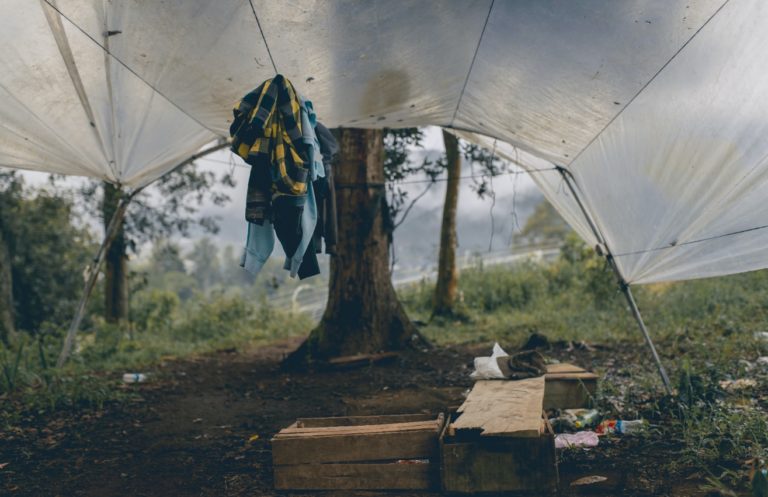For enjoying basic camping comfort, it is essential to know how to make a tarp shelter without trees. In fact, if you are carrying any survival kit, a polyethylene tarp is actually an indispensable item. It comes in handy to deal with emergencies. It is lightweight, extremely durable, waterproof and dirt-proof.
During camping emergencies, a tarp may help you to gather water, camouflage your camping supplies, and give you shelter when no other option is available. It is available in various colors and sizes and is quite affordable too. So you must know about tarp shelter configurations and designs to stay ahead in the game.

How to Make a Tarp Shelter (2 Best Methods Explained)
This section focuses on the various methods of setting up a tarp shelter. So if you are willing to learn how to make a tarp shelter, then you shouldn’t miss this section.
Method 1: Selection of a Good Spot
Select a Flat Area
Flat grounds are best for setting up a tarp shelter. This helps in setting up the shelter easily and allows the residents to get a flat surface for sleeping. Therefore, careful selection of the area is necessary for setting up a tarp shelter.
Find Dead Branches
Dead branches of the trees can pose a serious problem for the tarp shelters and the campers alike. It can be fatal too if it gets knocked down by the blowing winds. Therefore, the selection of a place for setting up the shelter preferably should not be below any tree especially those with dead branches. It can be very risky and dangerous.
Select Usable Trees
There are several types of tarp shelters that require placement of a strong cord or rope in between two trees. This rope or cord acts as the ridgeline for the tarp shelter. It is preferable to select a spot with a flat ground with two healthy trees without any dead or dry branches for secured placement of the cord.
If two trees in the required position are unavailable, then placing the two anchor branches on the ground is also helpful. These trees should remain at a distance as per the length of the rope.
Consideration of the Weather
While setting up the camp, the weather may remain sunny and favorable. But it may change during the course of the camping trip. The mood and tendencies of the weather in the near future should be taken into consideration. This step will keep the campers safe and comfortable causing no damage to the camping set up of tarp shelter or the mood of the adventure trip.
The direction of the wind should be carefully observed before setting up the camp. It is advisable that all walls of the tarp shelter should face away from the wind. Moreover, low areas should be avoided for camp set up to avoid the complications of water-logging and floods.

Method 2: Preparing a Frame Shelter
Creating a Ridge Line
The ridgeline is essential to support the top line of the tarp shelter designs. This line can be created by stringing the length of the cord amidst two trees. This provides the tarp with an elevated tip for support. Moreover, it gives the shelter the shape of the frame tarp shelter.
To get the ridgeline, one section of the rope should be tied to a tree. The height of the roof of the shelter should be determined according to the choice of the user. Then the other should be brought over to the adjacent tree at the same level. The cord should be tight, firm and secure to form a strong and supportive ridgeline.
Laying the Tarp Over the Rope
Once the firm ridge line is securely created the tarp can be laid on the top of it. To get an A-Frame tarp shelter, the tarp needs to be placed at the centre of the ridgeline. This will leave two halves of the tarp hanging on either side. The length of the tap should be equal on either side to avoid any problem during setting up.
Anchor the Tarp Securely to the Ground
Once the tarp is hanged equally in either side of the ridgeline, the bottom part can be fastened to the ground. A tent sake should be firmly placed to the ground near the corner endings of the stretched out tarp. Then securely fasten the cords with it on all the four corners.
From the above discussion on how to make a tarp shelter, it is clear that careful planning and keen observation along with proper guidance is essential to get optimum fun during a camping trip. Camping is a great way to experience the purity of nature. The fun of such an adventurous trip should not be tarnished because of reckless planning.
- Freediving Fins vs Scuba Fins: A Detailed Comparison - February 21, 2022
- How to Use Hammock Straps (A Step by Step Guide) - February 21, 2022
- 8 Best Places to Fish in Ohio (With Complete Details) - February 20, 2022
